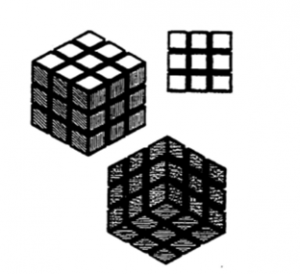On April 1996, a three-dimensional EUTM was filed in Class 28 (three-dimensional puzzles) as reproduced below.

The initial Applicant (Seven Towns) did not claim any particular color and provided any description of it. The trademark was granted for registration and assigned Nº 162784 on April 1999 and subsequently renewed as well as transferred to Rubik´s Brand Ltd. On November 2006, the intervener, Simba Toys GmbH & Co. KG, filed an application for a declaration of invalidity pursuant to Article 51.1, a) and in conjunction with Article 7.1, a) to c) and e) of the EUTM Regulation. The Cancellation Division rejected initially in its entirety the application. On 2008, Simba Toys file an Appeal which confirmed the decision on first Instance. By application lodged on November 2009, Simba Toys brought the matter to the General Court, who dismissed the case in its entirety. The judgement was appealed before the Court of Justice and the judgement was issued on November 2016 annulling the first decision.
By decision of 19 June 217, the EUIPO declared the challenged mark invalid by issuing a new decision stating that “in view of the fact that each of the essential characteristics of the sign at issue was necessary for the product represented by that sign to perform its technical function, the sign as a whole fell within the scope of the prohibition set out in Article 7.1, e) (ii).
Following this, Rubik´s Band Ltd. Appealed the decision before the General Court, relying on four pleas of law:
- First plea: infringement of Article 7.1. e) (ii).
The Court considers the first part of the plea: the Board of Appeal did not correctly identified the essential characteristics of the contested mark
The second part of the plea is however dismissed since given that the two characteristics of the contested mark have been identified correctly as essential, the overall cube shape and the black lines and the little squares on each face of the cube are necessary to obtain the technical result of the goods for which the mark was registered for (three dimensional puzzles). The Court points out that the applicant failed to explain to what extent the fact of having identified the differences in the colors on the six faces of the cube could have an effect on the operative part of the appeal.
- Second and third plea: infringement of Article 95.1 and second sentence of Article 94.1
The Court does not go into the merits as it has been already accepted by the Office that the assessment on the colors on the faces of the cube is not an essential characteristic.
- Fourth plea: infringement of Article 72.6
It is dismissed based on the reasoning given by the Court on the error of law of the General Court, in which it took the view that for the purposes of the examining the functionality of the essential characteristics, “it should have been taken as a basis, without it being necessary to take into consideration any additional circumstances which an objective observer would not have been able to fathom precisely on the basis of the graphic representations of the contested mark, ‘such as the rotating capability of individual elements in a three-dimensional “Rubik’s Cube”-type puzzle’”.
Judgment of the General Court (Eigth Chamber) of 24 October 2019. Case T601/17.


 Español
Español Deutsch
Deutsch